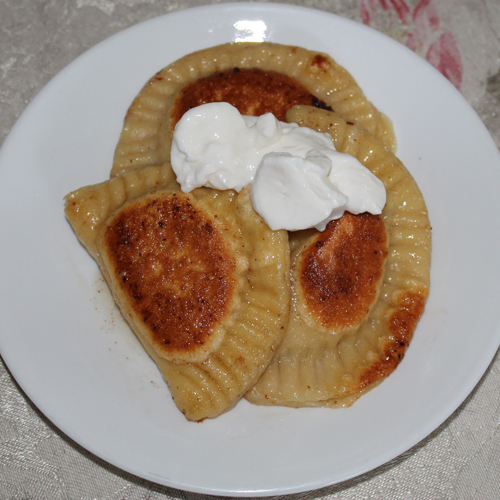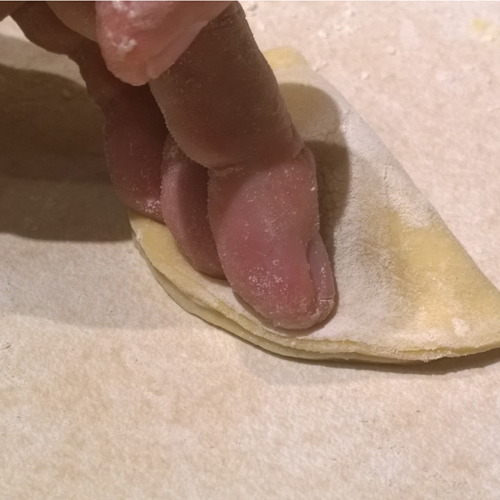
It’s Easter, and it’s Tax Season. Yes, this year those two are melded together, at least for me.
It’s this way—our tax guy loves my baking and cooking. And he knows I’m part Polish (the other parts are Slovak, Croatian and Russian). Every few years, we do a nifty barter for our taxes. This year, he asked for pierogi.
Pierogi are quintessential Polish comfort food. While the Chinese may have invented the concept the Italians call “ravioli,” the Polish took it to its perfection in the pierogi.
(Funny story: When I worked in the convent, our bookkeeper Rosanna (a lovely young woman from Italy) and I were talking about food. I mentioned pierogi, and she’d never heard of them. I was explaining, and she said, “Oh, they’re like—like, how do you say “ravioli” in English?”
I looked at her with a straight face, and said, “Ravioli.” I’ll never forget the “smack my head” look on her face!)
Pierogi are like ravioli with one basic difference: they’re made with only one piece of dough. The right dough really can make or break this dish, so you may want to stick with this recipe or find someone’s Polish granny who can show you hers.
The recipes are often handed down from generation to generation. Ours? Not so much. My paternal grandma, who was Slovak, took a stab at it with the Slovak-American cookbook, but those are heavier than I remember my maternal great-grandma’s recipe. And apparently, nobody thought to write that version down. Oh, and as a hint, it’s not “pierogis”—the word “pierogi” is plural. They’re always served in multiples, too.
Polish grammar lesson aside, let’s get started. This recipe is an amalgamation of the Slovak, the Polish and a few additions of my own (as always). I made three kinds of filling: potato, potato and cheese, and sauerkraut with shallot.
My great-grandma made pierogi almost every time we came over, about once a week. The Slovak side of the family had a traditional cold breakfast on Easter morning (after Mass, of course), which is how I grew up. After my dad died, we gradually changed things up. Pierogi made their appearance at the past two Christmas Eve dinners on my mom’s request. For us, they’re not as much of an Easter tradition; the pierogi came up this year simply because of our tax guy’s request.
The making of the pierogi is a tradition that we’ve sadly let slide in favor of the boxes in the freezer section. It was time to change that.
There is, however, a tradition we do have in our home. Every chance I get, I show the kids how to make a “family recipe.” Whether it’s my dad’s potica recipe, my grandma’s nadif recipe, or my aunt’s favorite strudel recipe, I’m the holder of the recipes, and these kids want to learn.
So they learn.
Pierogi do take some work; I won’t kid you. Of course, you can go buy them—far easier, right? But making them? And knowing what’s in them? Much better, so I started the Easter Pierogi Tradition with that in mind.
This is not a light dish. There’s a lot of butter. A lot. Technically, they can “pass” for a veggie dish if you use a vegetarian butter substitute and a sour cream substitute. Don’t feel guilty about the butter. Enjoy these peerless little pockets of pleasure. Life’s too short to guilt ourselves about a once-in-a-while treat.
Fillings (These should be done the day before, though I did the sauerkraut this morning).
Sauerkraut:
1 ½ cups sauerkraut, drained, then minced
1 large shallot, diced fine
3 T. butter
Salt & White Pepper to taste
Place the sauerkraut in a colander to drain, squeezing it out. Wrap it in a tea towel (Great-Granny’s way) and squeeze it again. Place the drained sauerkraut on your chopping board and cut it up—mince it so that you have a relatively fine dice.
Melt the butter over medium heat in a saute pan. Add the shallot and stir it around for 5 minutes (lower the heat if it’s browning too much). Then add the sauerkraut and heat it through. It should be slightly shiny with the butter, but not brown. Add salt and pepper to taste. Slide this mixture out of the pan and onto a plate and set aside.
Pat’s Mashed Potatoes (make these overnight):
(Mash 4 medium potatoes. I used butter (again) and organic half-and-half (no salt and pepper yet) and I whipped them—this is important! Whip the potatoes so they’re smooth but not loose. You want structure, but not chunks of spuds. Transfer this to a bowl and chill overnight.)
Peel and dice 4 medium russet potatoes. Bring water in a 4-quart pot to boil, with a little salt. Add the potatoes and cook (boiling) till they’re tender. Poke them with a fork after about 6 minutes. It should take no longer than 10 minutes, because you’ve diced them.
Drain them. Add ½ stick of butter to the pan, and about 3 T. half-and-half. Whip them with a hand mixer or stick blender till smooth. (Sorry—I can make these in my sleep—I had to think about how to make mashed potatoes!)
Makes about 4 cups.
When you’re ready to make the pierogi, heat 2 cups of mashed potatoes in a saute pan, with about 3 T. butter, and add salt and white pepper to taste. Put this on a plate when it’s heated through and loosened up, and set it aside.
Potato and Cheese:
Take half the mashed potatoes and heat them through in a saute pan with…butter. The potatoes can be golden, but again, not brown. Add salt and white pepper to taste.
Place 8 oz. of your favorite ricotta cheese in a bowl, add the potatoes and stir well. Add ½ tsp. parsley (just so you can tell the difference between these and the plain ones). Set this aside.

Dough.
Have a small bowl of water handy, a fork, and a 3” biscuit cutter—or use a glass! (These are your Pierogi Tools.)
There are a bunch of different recipes for dough. The Slovak cookbook my grandma gave me had a basic “flour, water, salt” recipe. I tried that one, and it was hard to work with. So I fiddled with it. This is what ended up with:
3 eggs (or your veg substitute)
8 oz. sour cream
2 ¾ cups all-purpose unbleached flour
½ t. salt
1 T. baking powder
Beat the eggs and sour cream together. Then add the dry ingredients and beat until it comes together. This is a sticky dough.
On a well-floured surface knead this—a lot—about 5 to 10 minutes. (See, this is where there’s no guilt—you’re getting a workout!) Add flour as needed as you’re kneading. The dough should be smooth, and it will be thick and heavy.
Divide the dough in half; wrap the other half in a tea towel and set it aside. Flour your area again, and roll the half-ball of dough out to slightly less than 1/8” thick. Use a 3” biscuit cutter—Great-Granny used a glass—to cut the circles, and take away the scraps.
(Note: The dough can be a little difficult! It will pull back on itself and not want to roll out. Think of this as an exercise in patience (as well as a great upper body workout), and you will be amply rewarded.)
Take a very scant ½ teaspoon of the filling and place it in the center of the circle of dough. Dip your index finger in the small bowl of water, and moisten the bottom rim of the dough circle. Fold the top over, making sure that all the filling stays inside. Tuck your next three fingers together and press the surfaces of the circle close to the filling (see picture above). Keep the wet finger away from the dough so you don’t tear it.
Dip the backs of the tines of a fork into flour, and press into the rim of the Pierogi, sealing it completely. Set them aside by flavors, so you can store them properly. Gather the scraps, and re-roll. Waste not, want not. Keep going.
When you’ve finished, let them air-dry a bit while you bring a large pot of salted water to boil.
You now have two options: Ready-to-freeze, or ready-to-eat.
Freezing:
Blanch the pierogi by placing about 6 to 8 of them in the pot of boiling water for 1 minute, then plunging them in a bowl of ice water for 1 minute. Set them back onto a parchment-lined cookie sheet. When you’re done, you’ll flash-freeze these on the sheet for a few hours. You can then put them in a storage container or bag and freeze them for up to a month, though you won’t want to!
To cook the frozen ones, see below. It may take a minute or two longer for them to float to the top.
Eating:
Bring that same pot of water to a boil. Add the pierogi (usually in batches), and when they float to the top—about 3 to 5 minutes—scoop them out with a slotted spoon and drain them.
From here, you now have two more options: As-is, or fried.
As-Is:
Place the pierogi on a plate, add a little salt and pepper, a dollop of sour cream, if desired, and eat. Or you can garnish with some melted butter and parsley. I’m totally serious about the butter.
Fried:
You still need to boil them first, to make them tender. See “Eating” above. In a large saute pan, melt—yes—butter, over medium heat. Place the pierogi in the pan, then cover. Saute about 3 minutes on each side, making them beautifully brown. You can also saute onions or shallots here, too, and serve the fried pierogi with the sautéed onions. And you can add sour cream if you want—or butter.
Notes:
**Buy organic whenever you can for any of these ingredients.
**I did a double-batch of dough. The recipe is for a single batch.
**This doesn’t take as long as you think. I did the potatoes last night. From start to finish today, it took us about three hours. It’s worth every minute.
**Savory filling ideas: Chopped mushrooms and sauerkraut. Potato and shredded cheddar. Potato, chopped garlic and onion. Spinach and feta. Potato and chopped cooked bacon. Sausage. Sauerkraut and chopped cooked bacon.
**White pepper is used because it’s pretty. If you want black pepper, then go for it. Make it your own.
This is a great recipe to do with your kids. It’s fiddly, yes. But teaching your kids to create something that they might normally see come out of a box? That in itself is worth all the chocolate bunnies at Easter.
So, in a few hours, my tax guy will have his pierogi. I’ll bring some over to my mom. And we’ll all enjoy the holiday—as well as the new holiday tradition.
~
Relephant Read:
The Vestal Vegan does Spring Asparagus. {Vegan Recipe}
~
Author: Pat Perrier
Editor: Toby Israel
Images: Author’s Own
~










Read 3 comments and reply